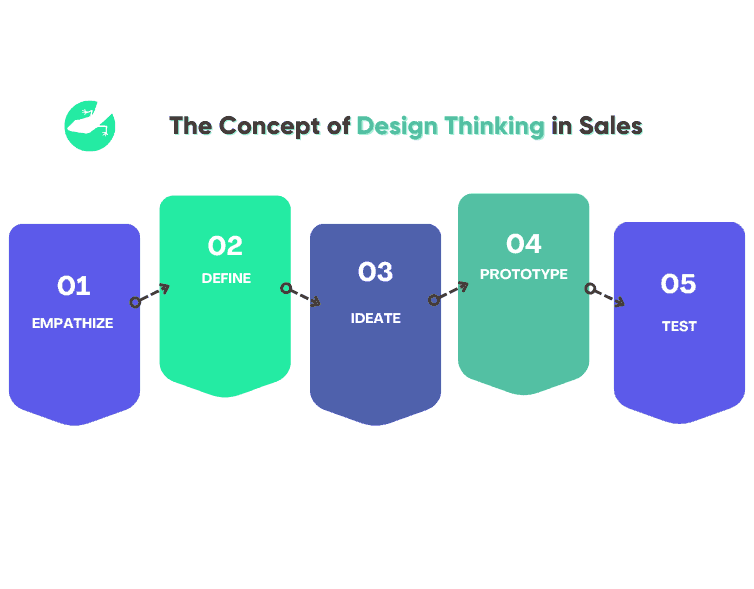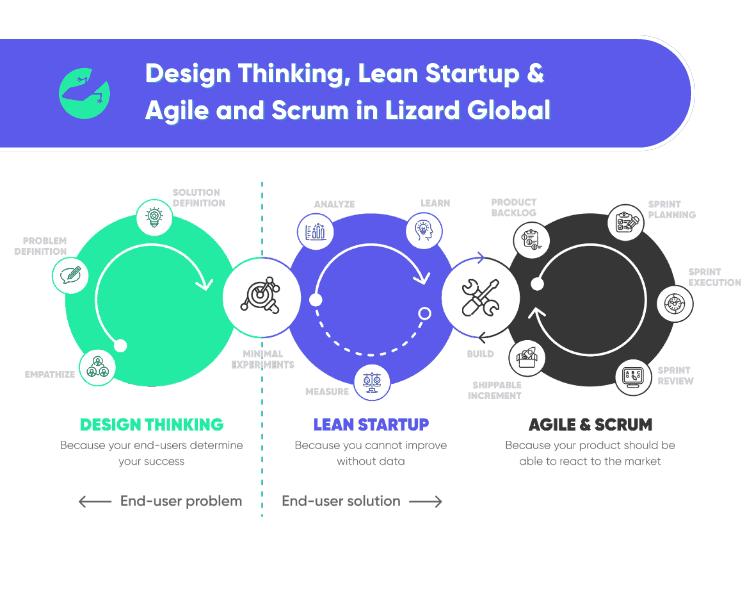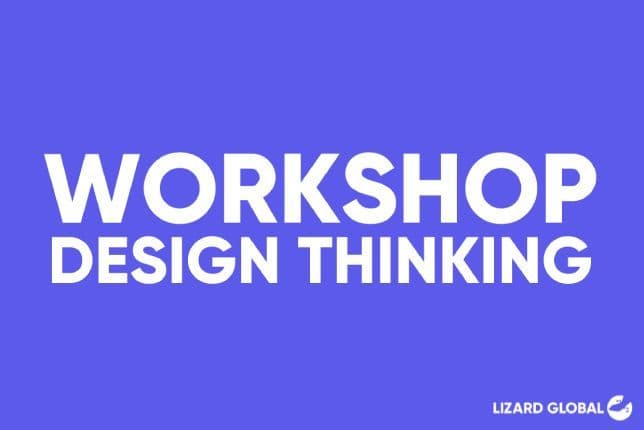design thinking
marketing
+ 2 more ...
Is Transforming Sales with Design Thinking Actually Any Good?
14 Nov 2023
by Asrul Ash, Content Writer
14 Nov 2023
by Asrul Ash, Content Writer
design thinking
marketing
sales
user centered
Is Transforming Sales with Design Thinking Actually Any Good?
Table of contents
Contact us
We will get back to you in the next 48 hours.

Is Transforming Sales with Design Thinking Actually Good
Design Thinking has potentially revolutionized the way sales teams approach their strategies and interact with customers. How? Read here!
Follow Lizard Global on Facebook, Instagram, and LinkedIn.
In an ever-evolving business landscape, organizations are continually seeking innovative ways to enhance their sales processes and boost revenue. One such approach that has gained significant attention in recent years is Design Thinking. But is transforming sales with Design Thinking actually any good? Can it lead to tangible improvements in sales strategies and outcomes?
In this blog post, we will delve into the world of Design Thinking and explore its impact on sales, highlighting its potential benefits and offering insights into whether it is a game-changer for sales teams.
The Essence of Design Thinking
Design Thinking is a problem-solving approach that places the end-user at the center of the innovation process. It encourages empathy, creativity, and iterative experimentation to develop solutions that meet user needs effectively. According to a report by McKinsey, organizations that prioritize design thinking have seen a 32% higher revenue growth compared to their peers. The numbers underscore its efficacy in delivering tangible results. While Design Thinking has been widely adopted in product design and development, it has also found its place in the sales arena.

The Role of Design Thinking in Sales
Here, we explore the pivotal role of design thinking in reshaping sales strategies and enhancing customer experiences, ultimately driving revenue growth and business success.
1. Understanding Customer Needs
One of the key advantages of using design thinking in sales is its ability to foster empathy. By empathizing with customers and truly understanding their challenges and aspirations, sales professionals can form authentic connections that go beyond transactional interactions. In today's highly competitive market, customers not only expect solutions to their problems but also seek brands that genuinely care about their well-being.
Design thinking enables sales teams to bridge this gap by creating a collaborative and solution-oriented environment. It encourages active listening, uncovering hidden insights, and co-creating solutions that resonate with the customer on a personal level. This approach results in more effective sales pitches, higher customer retention rates, and, ultimately, stronger, long-lasting customer relationships.
2. Innovative Solutions
Design thinking plays a big role in sales as it creates tailored, human-centric sales experiences. By deeply understanding the customer's needs, pain points, and aspirations, sales teams can develop solutions that genuinely resonate with their target audience. This not only leads to more effective sales processes but also fosters long-term customer relationships. Design thinking enables sales teams to move beyond generic, one-size-fits-all approaches and craft personalized, engaging experiences that drive customer loyalty.
Furthermore, it encourages sales professionals to look beyond the immediate transaction and focus on building trust, addressing challenges, and delivering value, ensuring a win-win for both parties involved. As a result, innovative sales solutions emerge, reshaping the traditional sales landscape and driving success in an ever-evolving market.
3. User-Centered Sales Processes
Design thinking encourages creativity and innovation in sales strategies. By taking a human-centric approach, sales teams can brainstorm and ideate around the real-life challenges customers face. This innovation-driven process often leads to the development of novel sales approaches that resonate with the customer on a deeper level. These solutions are not driven solely by numbers and revenue targets but are born out of a genuine desire to improve the customer experience. As a result, businesses can foster long-term loyalty and build lasting relationships with their clients.
4. Iterative Improvement
The concept of iteration emphasizes the importance of constantly refining and improving sales strategies based on real-world feedback and experiences. This iterative approach allows sales teams to adapt swiftly to changing market dynamics and customer preferences. By testing and refining sales strategies in a systematic manner, businesses can optimize their approaches, resulting in higher conversion rates, improved customer satisfaction, and increased sales revenue.
Furthermore, design thinking encourages a collaborative environment where sales professionals work closely with other departments, such as product development and marketing, to ensure that the entire customer journey is aligned with customer needs and expectations. In a rapidly evolving business landscape, design thinking fosters an agile and adaptive sales process that is essential for long-term success.

The Benefits of Applying Design Thinking to Sales
In today's dynamic business landscape, sales teams are increasingly turning to design thinking to elevate their strategies and foster deeper, more meaningful customer relationships. Here are some of the profound benefits that arise from applying design thinking principles to the realm of sales:
- Enhanced Customer Experience: Sales strategies that prioritize Design Thinking can lead to a superior customer experience, which is often a key driver of customer loyalty and repeat business.
- Increased Sales Conversion: By aligning sales strategies with customer needs, organizations are more likely to see increased conversion rates and higher sales.
- Competitive Advantage: Design Thinking allows businesses to differentiate themselves by offering unique and customer-centric solutions that competitors may not provide.
- Adaptability: With a focus on iterative improvement, organizations can quickly respond to changing market conditions and customer preferences.
- Innovation: Design Thinking can lead to the creation of innovative sales strategies that stand out in the market and drive business growth.
Lizard Global, Global’s Best Full-stack Web and Mobile Development Company
So, is transforming sales with Design Thinking actually any good? The answer is a resounding yes. Design Thinking has the potential to revolutionize the way sales teams approach their strategies and interact with customers. By putting the customer at the center of the sales process, organizations can improve customer experience, boost sales, gain a competitive edge, and continuously innovate. While it may require a shift in mindset and processes, the rewards of embracing Design Thinking in sales can be significant, making it an approach that is definitely worth exploring for businesses looking to stay ahead in the sales game.

Need a hand?
Ready to revolutionize your sales approach and achieve unprecedented success? Discover the innovative strategies and principles that can elevate your sales game to new heights. Don't miss this opportunity to explore a game-changing approach that has already transformed the way businesses approach their sales processes. Contact us today and kickstart your journey toward sales excellence with Lizard Global!


Is Transforming Sales with Design Thinking Actually Good
Design Thinking has potentially revolutionized the way sales teams approach their strategies and interact with customers. How? Read here!
Follow Lizard Global on Facebook, Instagram, and LinkedIn.
In an ever-evolving business landscape, organizations are continually seeking innovative ways to enhance their sales processes and boost revenue. One such approach that has gained significant attention in recent years is Design Thinking. But is transforming sales with Design Thinking actually any good? Can it lead to tangible improvements in sales strategies and outcomes?
In this blog post, we will delve into the world of Design Thinking and explore its impact on sales, highlighting its potential benefits and offering insights into whether it is a game-changer for sales teams.
The Essence of Design Thinking
Design Thinking is a problem-solving approach that places the end-user at the center of the innovation process. It encourages empathy, creativity, and iterative experimentation to develop solutions that meet user needs effectively. According to a report by McKinsey, organizations that prioritize design thinking have seen a 32% higher revenue growth compared to their peers. The numbers underscore its efficacy in delivering tangible results. While Design Thinking has been widely adopted in product design and development, it has also found its place in the sales arena.

The Role of Design Thinking in Sales
Here, we explore the pivotal role of design thinking in reshaping sales strategies and enhancing customer experiences, ultimately driving revenue growth and business success.
1. Understanding Customer Needs
One of the key advantages of using design thinking in sales is its ability to foster empathy. By empathizing with customers and truly understanding their challenges and aspirations, sales professionals can form authentic connections that go beyond transactional interactions. In today's highly competitive market, customers not only expect solutions to their problems but also seek brands that genuinely care about their well-being.
Design thinking enables sales teams to bridge this gap by creating a collaborative and solution-oriented environment. It encourages active listening, uncovering hidden insights, and co-creating solutions that resonate with the customer on a personal level. This approach results in more effective sales pitches, higher customer retention rates, and, ultimately, stronger, long-lasting customer relationships.
2. Innovative Solutions
Design thinking plays a big role in sales as it creates tailored, human-centric sales experiences. By deeply understanding the customer's needs, pain points, and aspirations, sales teams can develop solutions that genuinely resonate with their target audience. This not only leads to more effective sales processes but also fosters long-term customer relationships. Design thinking enables sales teams to move beyond generic, one-size-fits-all approaches and craft personalized, engaging experiences that drive customer loyalty.
Furthermore, it encourages sales professionals to look beyond the immediate transaction and focus on building trust, addressing challenges, and delivering value, ensuring a win-win for both parties involved. As a result, innovative sales solutions emerge, reshaping the traditional sales landscape and driving success in an ever-evolving market.
3. User-Centered Sales Processes
Design thinking encourages creativity and innovation in sales strategies. By taking a human-centric approach, sales teams can brainstorm and ideate around the real-life challenges customers face. This innovation-driven process often leads to the development of novel sales approaches that resonate with the customer on a deeper level. These solutions are not driven solely by numbers and revenue targets but are born out of a genuine desire to improve the customer experience. As a result, businesses can foster long-term loyalty and build lasting relationships with their clients.
4. Iterative Improvement
The concept of iteration emphasizes the importance of constantly refining and improving sales strategies based on real-world feedback and experiences. This iterative approach allows sales teams to adapt swiftly to changing market dynamics and customer preferences. By testing and refining sales strategies in a systematic manner, businesses can optimize their approaches, resulting in higher conversion rates, improved customer satisfaction, and increased sales revenue.
Furthermore, design thinking encourages a collaborative environment where sales professionals work closely with other departments, such as product development and marketing, to ensure that the entire customer journey is aligned with customer needs and expectations. In a rapidly evolving business landscape, design thinking fosters an agile and adaptive sales process that is essential for long-term success.

The Benefits of Applying Design Thinking to Sales
In today's dynamic business landscape, sales teams are increasingly turning to design thinking to elevate their strategies and foster deeper, more meaningful customer relationships. Here are some of the profound benefits that arise from applying design thinking principles to the realm of sales:
- Enhanced Customer Experience: Sales strategies that prioritize Design Thinking can lead to a superior customer experience, which is often a key driver of customer loyalty and repeat business.
- Increased Sales Conversion: By aligning sales strategies with customer needs, organizations are more likely to see increased conversion rates and higher sales.
- Competitive Advantage: Design Thinking allows businesses to differentiate themselves by offering unique and customer-centric solutions that competitors may not provide.
- Adaptability: With a focus on iterative improvement, organizations can quickly respond to changing market conditions and customer preferences.
- Innovation: Design Thinking can lead to the creation of innovative sales strategies that stand out in the market and drive business growth.
Lizard Global, Global’s Best Full-stack Web and Mobile Development Company
So, is transforming sales with Design Thinking actually any good? The answer is a resounding yes. Design Thinking has the potential to revolutionize the way sales teams approach their strategies and interact with customers. By putting the customer at the center of the sales process, organizations can improve customer experience, boost sales, gain a competitive edge, and continuously innovate. While it may require a shift in mindset and processes, the rewards of embracing Design Thinking in sales can be significant, making it an approach that is definitely worth exploring for businesses looking to stay ahead in the sales game.

Need a hand?
Ready to revolutionize your sales approach and achieve unprecedented success? Discover the innovative strategies and principles that can elevate your sales game to new heights. Don't miss this opportunity to explore a game-changing approach that has already transformed the way businesses approach their sales processes. Contact us today and kickstart your journey toward sales excellence with Lizard Global!

FAQs

Can design thinking be applied to any type of business or industry?
What are some examples of companies successfully using design thinking in sales?
How can Lizard Global help businesses implement design thinking in their sales strategies?
Is design thinking a one-time solution, or does it require continuous effort?
How can I get started with implementing design thinking in my sales processes?







